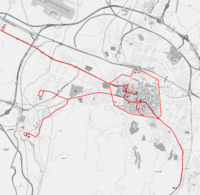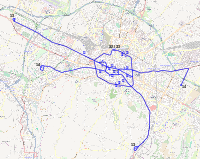Trolleybuses in Bologna
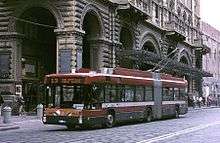 Autodromo (CAM) / MAN articulated trolleybus (2nd series) no. 1044 on Via Rizzoli. | |||||||||||||
| Operation | |||||||||||||
|---|---|---|---|---|---|---|---|---|---|---|---|---|---|
| Locale | Bologna, Emilia-Romagna, Italy | ||||||||||||
| |||||||||||||
| |||||||||||||
| |||||||||||||
The Bologna trolleybus system (Italian: Rete filoviaria di Bologna) forms part of the public transport network of the city and comune of Bologna, in the region of Emilia-Romagna, northern Italy. In operation since 1991, the current system comprises four urban routes, and additional routes are presently under construction.
Bologna has had two earlier trolleybus systems. The first one opened in 1940 and lasted only until 1945.[1][2]
The second earlier system, which was more extensive than the present one, opened in 1955 and was closed in 1982. At the time of its maximum extent in the 1960s and 1970s, it had a total of six routes.[1][3]:275
History
The first Bologna trolleybus system was opened in October 1940, to integrate with the tramway, as in many other Italian cities. This system, however, lasted only a few years until closed in 1945, as a result of damage sustained to its infrastructure during World War II.
The second trolleybus system was opened in 1955, in anticipation of the total replacement of trams (which were completely eliminated in 1963). However, the second system never reached a large extent, always remaining a minor network compared to the diesel powered bus network.
At the time of its maximum extent (in the 1960s and 1970s), the second system was composed of two circular and four radial lines:
- 32 Circolare esterna destra (right external circular, i.e. clockwise);
- 33 Circolare esterna sinistra (left external circular; i.e. counterclockwise);
- 41 Via Lame – Villaggio INA Casa (Borgo Panigale);
- 42 Piazza Malpighi – Casalecchio;
- 43 Piazza Maggiore – Villaggio CEP (Quartiere Barca);
- 46 Piazza Minghetti – San Ruffillo.
Line 42, with an outer terminus in Casalecchio di Reno, was the only one to exit the municipal area; it provided a service that was integrated with the Casalecchio–Vignola railway.
The radial lines had reversing loops at intermediate points on the route:
- on line 41 at Palasport, at Cinta Daziaria and at Borgo Panigale (Via della Salute);
- on line 42 at Croce di Casalecchio;
- on line 43 at Stadio;
- on line 46 at Chiesa Nuova and in Via della Direttissima.
As in other Italian cities, the trolleybus system experienced a decline in the second half of the 1970s, with the phasing out of the lines (converted to bus lines), with line 46 closing (converted to buses) on 1 August 1977; followed by lines 32, 33 and 43 on 30 September 1979; and line 42 on 30 September 1981.[3]:305 The final closure was of line 41 on 1 June 1982 — a "temporary" withdrawal of trolleybuses for the summer which was made permanent on 16 September 1982.[3]:305 Another source gives the last day of service as 14 June 1982.[1] The fleet was eventually disposed of.
1990s revival
The overhead wires, however, were left intact, so as to allow for a possible future decision to reopen the system.[4] By 1985, it had been tentatively decided that trolleybus service in Bologna should be revived, with a new fleet of vehicles.[5] In 1988, orders were placed for a fleet of 20 new trolleybuses: 10 from Menarini and 10 from Breda.[6] It was decided that the first line of the reactivated system would be line 13, which was a union of the old lines 41 and 46, with some changes in the city centre portions to connect the two — in particular, new wiring along Via San Felice, Via Rizzoli, Via Santo Stefano and other streets for eastbound trolleybuses.[7] Line 13 would now be a cross-city radial line from Borgo Panigale to San Ruffillo via the city centre.[8] The long-disused overhead wires along former routes 41 and 46 were refurbished in preparation for a planned 1990 reopening. By spring 1990, delivery of both types of new trolleybuses had begun. A ceremonial "inauguration" event took place on 20 April 1990, in connection with a transport conference being held, with one trolleybus of each type running over a short section of the route that was temporarily energised for the occasion.[7]
The first passenger service on the reopened trolleybus system, on new line 13, began on 4 January 1991[1][2] or 2 January.[3]:489 Route 13 remained the only trolleybus line until 2002.
On 14 October 2002, the second stage of expansion was reached, with the reactivation of the circular lines 32 and 33, following the same routings as in the previous trolleybus system, but with refurbished overhead wiring.[9]
Another 10 years passed before the next trolleybus line was opened. This occurred on 24 September 2012,[10] with the partial conversion to trolleybuses of bus line 14, Piazza Giovanni XXIII – Due Madonne Depot (bus garage) via the city centre. The western half of line 14 had been line 43 of the previous system (the terminus having been called Barca during that period, but following exactly the same routing to Piazza Giovanni XXIII), so this was a reactivation of former line 43, now as part of line 14. The eastern half of line 14 had never previously been a trolleybus line.[10] Initially, service on line 14 remains mostly operated with motorbuses, with trolleybus serving only about one-quarter of its trips. This is due partly to there being too few trolleybuses available in the fleet and partly to the fact that line 14 has three branches at its eastern end, two of which are not equipped with trolleybus wiring. The trolleybuses in the current fleet have diesel engines enabling them to operate away from the trolley wires, but only to a limited extent. The 11 newest trolleybuses, delivered in 2010 by Solaris Bus & Coach, have more powerful diesel engines, and initially they are the only trolleybuses being used on line 14, along with many diesel buses for the time being.[10]
On 1 February 2012, ATC transferred operation of Bologna's public transport system to Trasporto Passeggeri Emilia-Romagna SpA (TPER), a new entity formed by the merger ATC's operations division with Ferrovie Emilia Romagna (FER).[11]
Services

Overview
The four routes comprising the present Bologna trolleybus system are:
- 13 Borgo Panigale – centro (city centre) – San Ruffillo
- 14 Piazza Giovanni XXIII - Due Madonne (partially trolleybus-operated; mostly motorbus-operated currently)
- 32 Circolare destra (clockwise circular)
- 33 Circolare sinistra (counterclockwise circular)
Currently, all lines in service are equipped with special devices located on the same remote to transmit a "wire fall or break alarm" resulting in a precautionary tripping of power switches. It is also planned to raise the line voltage from 650 to 750 V.
Line 13
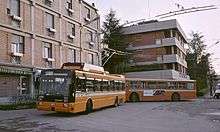
This line was born from the union of the previous lines 41 and 46 and was activated for testing in 1990 on the route San Ruffillo (Ponte Savena) – Borgo Panigale (INA Normandia), with regular public service being introduced on 4 January 1991.[2]
The line was initially powered by five electrical substations (Borgo Panigale, Tofane, Avesella, Carducci, Murri). In 2005, the Avesella substation was dismantled (due to its incompatibility with the urban electrical network), and the electrical sections Timavo–Centro and Centro–Porta Santo Stefano were combined into a single Timavo–Porta Santo Stefano section.
In 2003, work began on the extension of the line by about 900 m (3,000 ft) to Via Pavese, with the consequent shifting of line 13's San Ruffillo terminus from Ponte Savena to Via Pavese, and the construction of a new electrical substation at Via Pavese to provide power for the extension. The work was completed during the first half of 2007, and the extension was opened for service on 13 September 2007,[12] to coincide with the introduction of the new winter schedule.
Construction of an extension beyond Via Pavese to Rastignano is planned.
Lines 32 and 33

These two lines run along the ring boulevards, and represent the ATC's circular external network. They are electrically connected and are powered by two electric substations (San Isaia, Carducci).
Line 14
This line is a union of pre-1982 trolleybus line 43 (Barca), west of the city centre, with a new route east of the city centre to form a double-ended radial route (or cross-city route), between the Barca district and the San Vitale district. It existed in this form as a bus route for many years before the start of its phased conversion to trolleybuses in 2012. The eastern half was built from scratch, having never previously been a trolleybus route.[10] Along the western half, to Piazza Giovanni XXIII in the Barca district, the old trolleybus wiring was completely renewed, but the support poles were re-used. Most works were completed in 2006, but the line's opening was delayed. In the meantime, the planned line 14 had been extended, by the addition of two branches on the eastern section: 14A (the main line) to the end of Via Due Madonne (depot) and 14C to the end of al Pilastro (as well as a third branch, 14B, for the Roveri industrial area, to operate only in the morning rush hour).
After a delay of several years, caused in part by a shortage of trolleybuses, a limited use of trolleybuses in service on line 14 finally began on 24 September 2012.[10] Trolleybuses operate on the route on weekdays only, and most scheduled journeys continue to be operated by buses, until additional trolleybuses are acquired. The B and C branches are not equipped with wiring. At the time of opening for trolleybuses, the A branch was also not yet equipped with wiring along its outermost section, from Rotonda Paradisi to Via Due Madonne, but construction work was under way. At Due Madonne terminus, trolleybuses and buses on line 14A eventually will turn around at a new roundabout at the intersection with Via Malvezza. However, initially they are entering the ATC bus depot to turn around, pending completion of construction.
Line 14 is fed by five substations (Barca, Tofane, San Isaia, Carducci, Massarenti). Two additional substations in Via Madonna will feed the extension currently under construction.
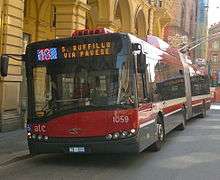
Trolleybus fleet
The Bologna trolleybus system is operated by the ATC, which currently has 45 trolleybuses:
- 9 Menarini M220 LU (nos. 002–010), 12 m (39 ft 4 in), 20 seats, 75 standing places;
- 1 Breda 4001.12 (no. 011), 12 m, 20 seats, 75 standing places (last remaining of nos. 011–020);
- 20 Autodromo/MAN articulated trolleybuses 1st series (nos. 1021–1040), 36 seats, 108 standing places;
- 15 Autodromo/MAN articulated trolleybuses 2nd series (nos. 1041–1055), 37 seats, 102 standing places;
- 11 Solaris Trollino articulated trolleybuses (nos. 1056–1066).
See also
References
- 1 2 3 4 Murray, Alan (2000). World Trolleybus Encyclopaedia, p. 69. Yateley, Hampshire, UK: Trolleybooks. ISBN 0-904235-18-1.
- 1 2 3 Gregoris, Paolo; Rizzoli, Francesco; Serra, Claudio (2003). Giro d'Italia in filobus [Tour of Italy by Trolleybus] (in Italian). Cortona: Calosci Editore. pp. 157–165. ISBN 88-7785-193-7.
- 1 2 3 4 Formentin, Fabio; Rossi, Paolo (1998). Storia dei Trasporti Urbani di Bologna [History of Transport in Bologna] (in Italian) (2nd ed.). Cortona: Calosci Editore. ISBN 88-7785-148-1.
- ↑ Trolleybus Magazine No. 128 (March 1983), p. 43. National Trolleybus Association (UK). ISSN 0266-7452.
- ↑ Trolleybus Magazine No. 141 (May–June 1985), p. 71.
- ↑ Trolleybus Magazine No. 163 (January–February 1989), p. 21.
- 1 2 Trolleybus Magazine No. 176 (March–April 1991), p. 43.
- ↑ Trolleybus Magazine No. 171 (May–June 1990), p. 71.
- ↑ Trolleybus Magazine No. 247 (January–February 2003), p. 19.
- 1 2 3 4 5 Trolleybus Magazine No. 307 (January–February 2013), pp. 22–24. National Trolleybus Association (UK).
- ↑ "Chi Siamo" [Who We Are (or: About Us)] (in Italian). TPER. Retrieved 6 December 2013.
- ↑ Trolleybus Magazine No. 277 (January–February 2008), p. 16. National Trolleybus Association (UK). ISSN 0266-7452.
External links
![]() Media related to Trolleybuses in Bologna at Wikimedia Commons
Media related to Trolleybuses in Bologna at Wikimedia Commons
- Images of the Bologna trolleybus system, at railfaneurope.net
- Images of the Bologna trolleybus system, at photorail.com
